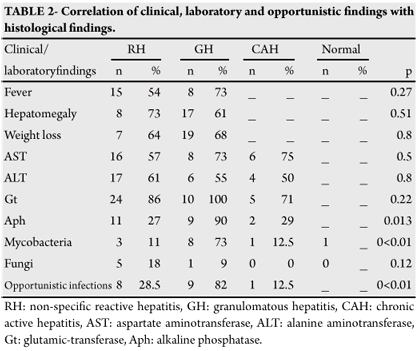INTRODUCTION: to evaluated the type histopathological hepatic lesions and opportunistic agents in Brazilian HIV-infected patients. METHODS: we examined 52 percutaneous liver biopsies of 50 HIV-infected patients who had at least two of the following conditions: fever of unknown origin, unexplained severe emaciation, hepatomegaly or abnormal liver chemistry. The specimens were cultured for mycobacteria and fungi and stained by standard procedures. RESULTS: reactive patterns, granulomatous hepatitis and chronic active hepatitis were verified in 28 (54%), 11 (21%) and 8 (15%) of the patients respectively. Opportunistic infections were diagnosed in 18 (36%) patients: mycobacteria in 12 (24%), Cryptococcus neoformans in 5 (10%) patients and mycobacteria and yeast was isolated from the same liver fragment in one patient. CONCLUSIONS: mycobacteriosis was the most common opportunistic infection and liver tissue culture is an important method to detect opportunistic agents, even in the absence of histological lesions.
Liver biopsy; Mycobacteriosis; AIDS; Liver histology



